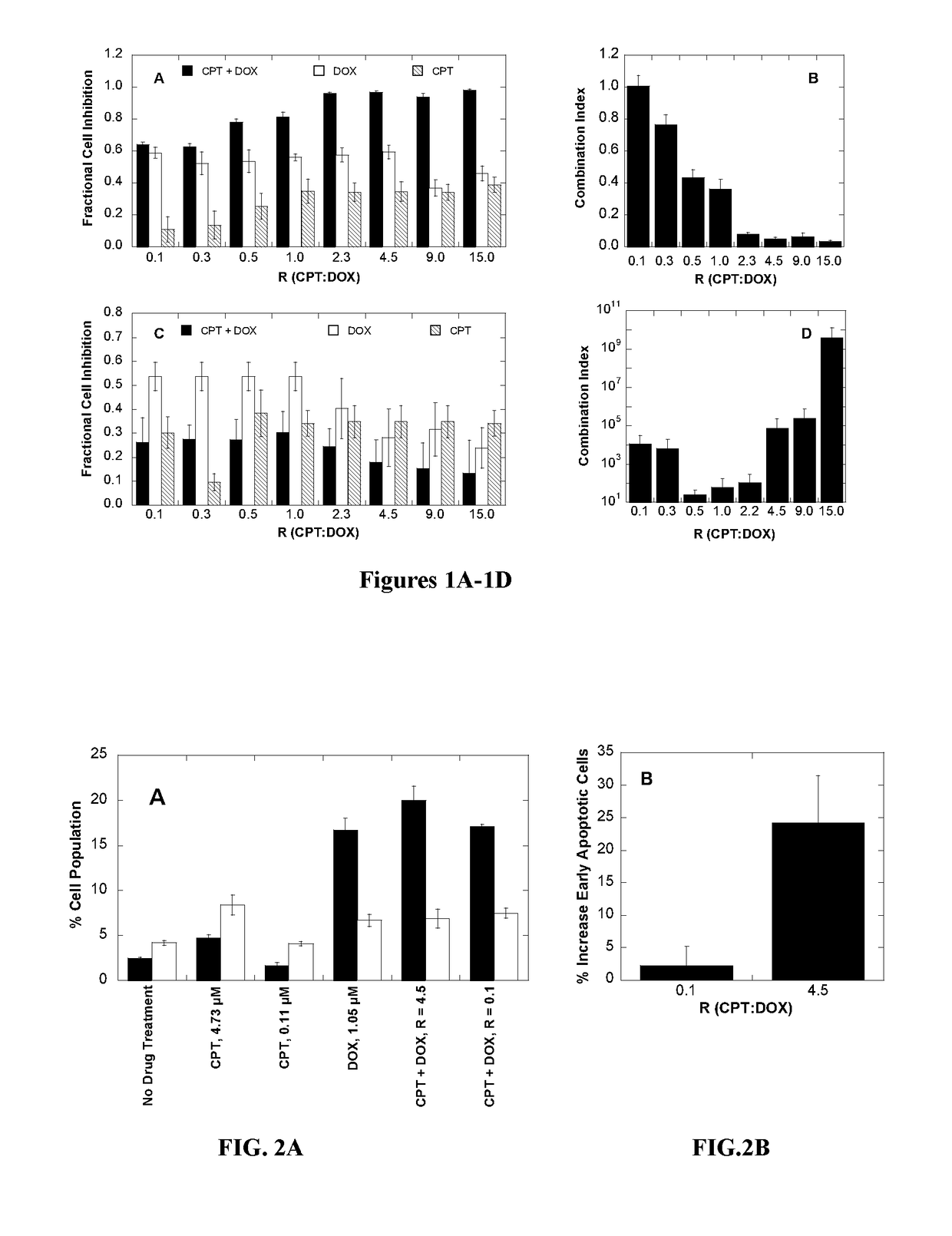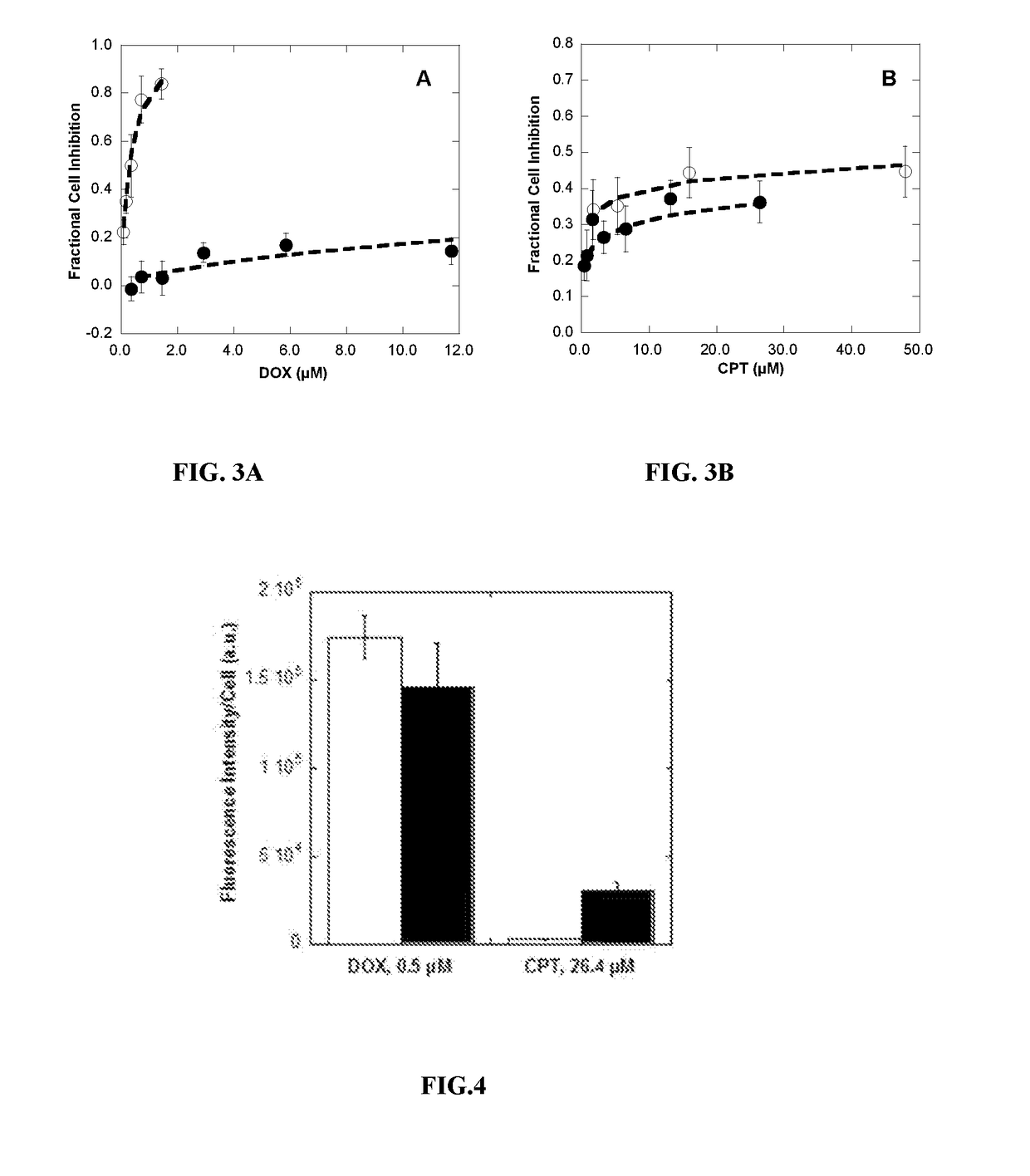Polymer-drug conjugates for combination anticancer therapy
a technology of conjugates and drugs, applied in the direction of antineoplastic agents, organic active ingredients, drug compositions, etc., can solve the problems of not showing improvement in efficacy, the clinical studies of these combinations have not progressed beyond phase ii trials, etc., and achieve the effect of reducing side effects and preventing tumor growth
- Summary
- Abstract
- Description
- Claims
- Application Information
AI Technical Summary
Benefits of technology
Problems solved by technology
Method used
Image
Examples
example 1
Synthesis of Hyaluronic Acid Conjugates
[0116]Materials and Methods
[0117]Camptothecin (CPT), N-(3-Dimethylaminopropyl)-N′-ethylcarbodiimide hydrochloride (EDC), 4-(dimethylamino)pyridine (DMAP), ethylenediamine, Tween-80 and rhodamine B (RhoB) were purchased from Sigma-Aldrich (St. Louis, Mo., USA). Doxorubicin (DOX) was obtained from LC Laboratories (Woburn, Mass., USA). Hyaluronic acid (HA) of 250 kDa MW was purchased from Creative PEGWorks (Winston Salem, N.C., USA). Sephadex G-25 PD-10 columns were obtained from GE Healthcare Life Sciences (Piscataway, N.J., USA).
[0118]CPT and DOX were conjugated to HA via nucleophilic acyl substitution according to the procedures in Scheme 1.
[0119]CPT-conjugation was achieved via ester formation (Lee, et al., Bioconjug Chem, 2008. 19(6): p. 1319-25) to the carboxylic acid moieties on hyaluronic acid or aminolysis for DOX-conjugation (Minko, et al., Int J Cancer, 2000. 86(1): 108-17). For each reaction, 100 mg of 250 kDa MW HA was dissolved in a ...
example 2
Cell Viability and Drug Combination Studies
[0123]Materials and Methods:
[0124]3-(4,5-Dimethylthiazol-2-yl)-2,5-diphenyltetrazolium bromide (MTT), from Thermo Fisher, DRAQS, and Hoechst were purchased from Invitrogen Life Technologies. Breast cancer HER2-overexpressing cell line BT-474, mouse metastatic breast cancer cell line 4T1, mouse brain endothelial cell line bEnd.3, Hybri-Care medium, Dulbecco's Modified Eagle's medium (DMEM) and cell culture grade water were acquired from ATCC. Fetal bovine serum (FBS), phosphate buffered saline (PBS), RPMI-1640 media, 2-(N-morpholino)ethanesulfonic acid (MES) buffer, 0.25% trypsin, penicillin / streptomycin, and Nunc Lab-Tek 8-chambered cover glasses were purchased from Thermo Scientific. Cell culture flasks and microplates were purchased from Corning (N.Y., USA). Microcentrifuge filter tubes were purchased from EMD Millipore (Billerica, Mass., USA).
[0125]Cell Culture
[0126]All cell lines were grown in a humidified incubator with 5% CO2 at 3TC. ...
example 3
Annexin V / Sytox Green Apoptosis Assay
[0137]Materials and Methods
[0138]Apoptosis assessment was made based on Annexin V and Sytox Green counterstaining. Studies followed the Life Technologies Apoptosis Assay protocol, with few modifications tailored to BT-474 cells. Briefly, cells were seeded at a concentration of 100×104 cells per 25 cm2 cell culture flask in a total volume of 10 mL media, and allowed to adhere overnight. Media was then decanted and replaced with fresh media containing drug(s). Drugs were first dissolved in DMSO and further diluted in media such that cells were not exposed to more than 0.2 vol % DMSO. Cells were incubated in the presence of drug(s) for 72 hours. After drug exposure, cells were harvested at a concentration of 1×106 cells / mL in Annexin V binding buffer, and 200 μL of each sample were incubated with 5 μL of Annexin V-647 and 1 μL of 1 μM Sytox Green. After 15 minutes of dye incubation, cells were diluted 5× in ice cold Annexin V Binding Buffer, and imm...
PUM
| Property | Measurement | Unit |
|---|---|---|
| Molar ratio | aaaaa | aaaaa |
| Bond strength | aaaaa | aaaaa |
| Biocompatibility | aaaaa | aaaaa |
Abstract
Description
Claims
Application Information
 Login to View More
Login to View More - R&D
- Intellectual Property
- Life Sciences
- Materials
- Tech Scout
- Unparalleled Data Quality
- Higher Quality Content
- 60% Fewer Hallucinations
Browse by: Latest US Patents, China's latest patents, Technical Efficacy Thesaurus, Application Domain, Technology Topic, Popular Technical Reports.
© 2025 PatSnap. All rights reserved.Legal|Privacy policy|Modern Slavery Act Transparency Statement|Sitemap|About US| Contact US: help@patsnap.com



